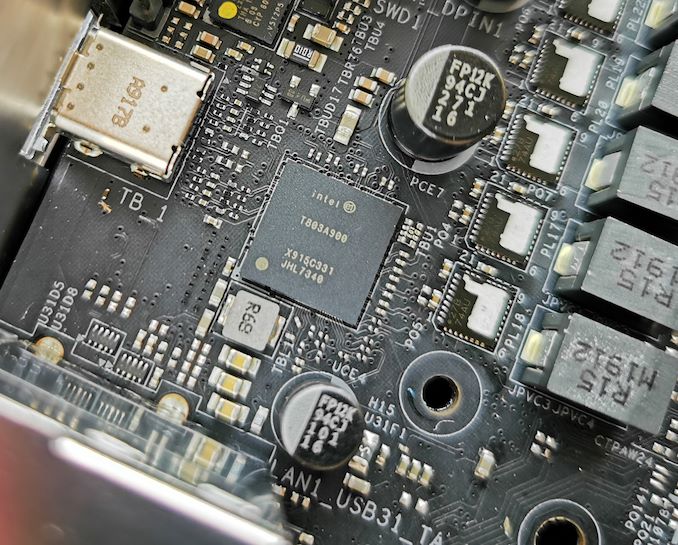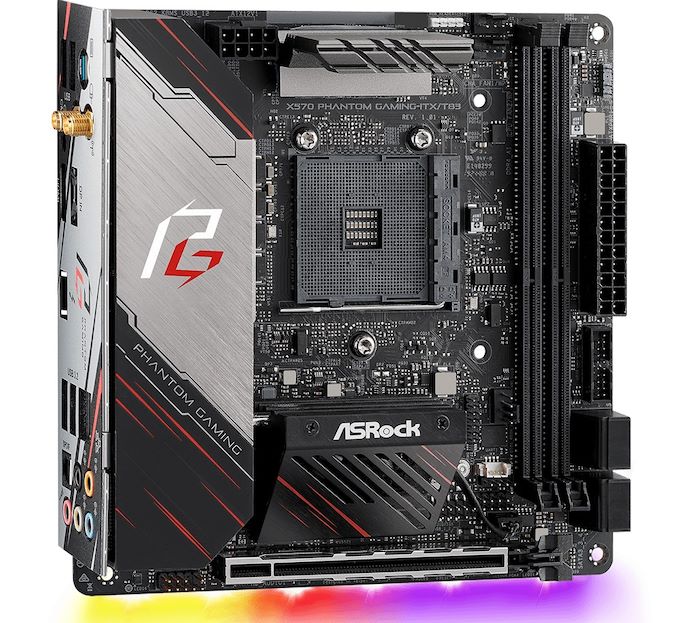AMD + ITX + TB3? It's the ASRock X570 Phantom Gaming-ITX/TB3 Motherboard Review
by Gavin Bonshor on October 9, 2019 12:00 PM ESTASRock X570 Phantom Gaming-ITX/TB3 Conclusion
The ASRock X570 Phantom Gaming-ITX/TB3 ($240) is one of just three mini-ITX motherboards across three different vendors on the X570 chipset. This makes it an interesting space for the vendors to get everything right as the GIGABYTE X570 I Aorus Pro WIFI ($220) and the ASUS ROG Strix X570-I Gaming ($299) are the only other two models to truly occupy this ITX space. Each has its own take on mini-ITX on X570, but the standout board on paper is almost certainly the ASRock X570 Phantom Gaming-ITX/TB3; not just based on features, but the combination of features for the price.
One of the primary features which sets the Phantom Gaming-ITX/TB3 apart from the competition is the inclusion of an Intel JHL7340 Thunderbolt 3 controller. This adds a single Type-C port on the rear panel, as well as a DisplayPort 1.4 input for users looking to drive multiple displays with resolutions of up to 4K from a discrete graphics card. On top of this is a Realtek ALC1220 HD audio codec which powers both the rear panel audio connections and the front panel audio header.
Also on the rear panel is an HDMI 2.0 video output for users of Ryzen's APUs, two antenna ports for the Intel AX200 802.11ax wireless interface, and just four USB 3.1 G1 Type-A ports. Aside from the four Type-A on the rear panel, users can expand this through the USB 3.1 G1 and USB 2.0 headers with each offering support up to two ports. For reference, the GIGABYTE X570 I Aorus Pro WIFI has five Type-A ports on the rear panel and doesn't include Thunderbolt 3 connectivity.
The GIGABYTE X570 I Aorus Pro WIFI is slightly cheaper but trades the Thunderbolt 3 for an extra M.2 slot. The main caveat of the single PCIe 4.0 x4 M.2 slot on the ASRock board is that it's located on the rear of the PCB meaning users with NVMe drives could experience some throttling under heavy loads, and the best approach to take would be to ensure adequate passive cooling for the rear of the board. Users looking to use SATA will need to use the four SATA ports available in the bottom right-hand corner of the board. With the board being mini-ITX, there's no scope to add additional M.2 slots with add-on cards like there is on ATX models. Memory support is very good with support for up to DDR4-4533 and up to 64 GB of total capacity. AMD Ryzen 3000's sweet spot for memory is DDR4-3600, so maximizing performance isn't too much of a concern with the insanely fast DDR4 kits, but ASRock does give users the option if they wish to do so.

ASRock loves adding Thunderbolt 3 capability
The performance of the ASRock X570 Phantom Gaming-ITX/TB3 is highly competitive and shines in the two areas most ASRock models we've seen of late generally do; POST time and out of the box DPC latency performance. Overall performance in our computational benchmarks was average with some good showing in benchmarks such as 3DPM but lower than usual results in Blender. Our overclocking performance testing proved that the ASRock X570 Phantom Gaming-ITX/TB3 is efficient in terms of load CPU VCore with the default LLC profile with good VDroop control and under volting where it's needed. Even though there are no overclocking presets for the CPU, the Eco mode which stated 45 W as opposed to our Ryzen 7 3700X's 65 W TDP proved very fruitful for users looking to build a slightly lower-powered small form factor system; Eco mode performance was on par with 3.8 GHz performance in our manual testing.
Turn the Lights Off, Carry Me Home

ASRock Phantom Gaming X570-ITX/TB3
For users looking to build a small form factor system using Ryzen 3000 with Thunderbolt 3 devices, the ASRock X570 Phantom Gaming-ITX/TB3 is a no brainer at just $240.The ASRock X570 Phantom Gaming-ITX/TB3 in our opinion continues ASRock's recent trend of providing formidable mini-ITX solutions. We can't wait to fit one with a 16-core Ryzen 9 3950X, which is expected to hit shelves in November.











64 Comments
View All Comments
drexnx - Wednesday, October 9, 2019 - link
even before I knew it was a blink 182 reference, I still read it as "all the...small things"Tuxie - Wednesday, October 9, 2019 - link
I'm still waiting for a Mini-ITX board with AM4, 2x M.2 and 10GbE. No need for WiFi, SATA, TB or onboard DP/HDMI.jeremyshaw - Wednesday, October 9, 2019 - link
The last part is what kills this board for me. It wastes space on DP and HDMI (technically, just HDMI, since the DP is an input for the TB3), when it already has a TB3/USB-C connection to handle video output. If someone insists on using a $220 board for a 3400G (and I am being extremely generous here), let them fall on their own sword. Let them spend the extra $20-30 on a DP-->HDMI adapter. Don't waste precious space on this board with a HDMI connector.Even worse, the Intel version of this board has all of the same outputs, PLUS two more USB ports and another M.2 slot. So no matter how I slice it, this board is down on features vs existing ASRock boards. From what I understand, ASRock didn't link the M.2 slot to the extra 4 PCIe lanes from the CPU, either, so it's sharing bandwidth from the chipset (with LAN & TB3), just like the Intel board. What a waste.
umano - Friday, October 11, 2019 - link
I totally agree, let's hope in the futureFiveOhFour - Saturday, January 11, 2020 - link
i agree but the hdmi part isn't fair it makes sense given how common this form factor is for use as a home theatre pcFiveOhFour - Saturday, January 11, 2020 - link
thats a major dissapointment though for sure, so whats the best option for x570 boards with thunderbolt, aside from the $1,000 white one. I don't need a certain form factor, though it would've been nice, just the best/most features and quality and priceValantar - Wednesday, October 9, 2019 - link
They're not going to make a premium ITX board without WiFi - too risky in terms of lost sales. A lot of SFF PC users move their PCs around, and not all places have Ethernet available. Also, ditching SATA seems early - people have legacy devices still (though cutting it down to 2 SATA probably wouldn't be a deal breaker for many). Likely all of this could be fit on board if they went with some sort of stacked m.2 layout like the Gigabyte or the Strix.Beyond that, I agree on faster networking though. Even one of those Realtek 2.5GB controllers would be a huge (well, 2.5x) improvement. Fitting a 10GbE controller might be too tight of a fit, sadly. But maybe on a daughterboard/some sort of vertical m.2 board like WiFi controllers?
DanNeely - Wednesday, October 9, 2019 - link
I doubt we'll see many 2 sata boards anytime soon; but the total is dropping and starting to shift downward. Looking at newegg listings, and limiting AMD to x70 boards since the remainder of the 5xx series isn't out yet:x370 3x 4 ports, 29x 6 ports, 76x 8 ports, 2x 10 ports.
x470 21x 4 ports, 147x 6 ports, 19x 8 ports
x570 36x 4 ports, 181x 6 ports, 83x 8 ports.
10 ports has disappeared as an option. 4 ports has grown from 3 to 11% of the total, and despite bouncing back a bit this year 8 port models are a minority of designs now vs the default in x370 boards.
On the intel side, and sticking to Z series boards to stay with the same general market segment as AMD:
Z170: 3x 2 port boards, 20x 4 port, 68x 6 ports, 8x 8 ports.
Z270: 9x 4 port, 74x 6 port, 19x 8 ports.
Z370: 43x 4 port, 129x 6 port, 1x 8 port
Z390: 66x 4 port, 476x 6 port, 18x 8 port.
Similar trends overall; 8 port is much less common on Intel boards because their consumer chipsets only have 6 sata ports available; 8+ requires a 3rd party controller and has been much less common for years as a result.
With both brands I suspect the transition will be slow because consumer boards suffer from feature checkboxitis and the connectors are cheap. Reducing support on the chipset would push things faster but sata controllers are relatively small/cheap compared to top of the line USB/PCIe ones and both companies are doing variations of the flexible IO port thing so it doesn't cost them much either. It'll happen eventually, but I don't expect to see much movement until the price/GB gap narrows at lot between SSD and HDDs because of people wanting to make DIY NAS/Storage servers.
Heavenly71 - Wednesday, October 9, 2019 - link
Sadly this board severly lacks USB ports. And it also doesn't have an internal header for front panel USB-C.imaheadcase - Wednesday, October 9, 2019 - link
That isn't really a issue considering all the options you can add usb to a system now-a-days.